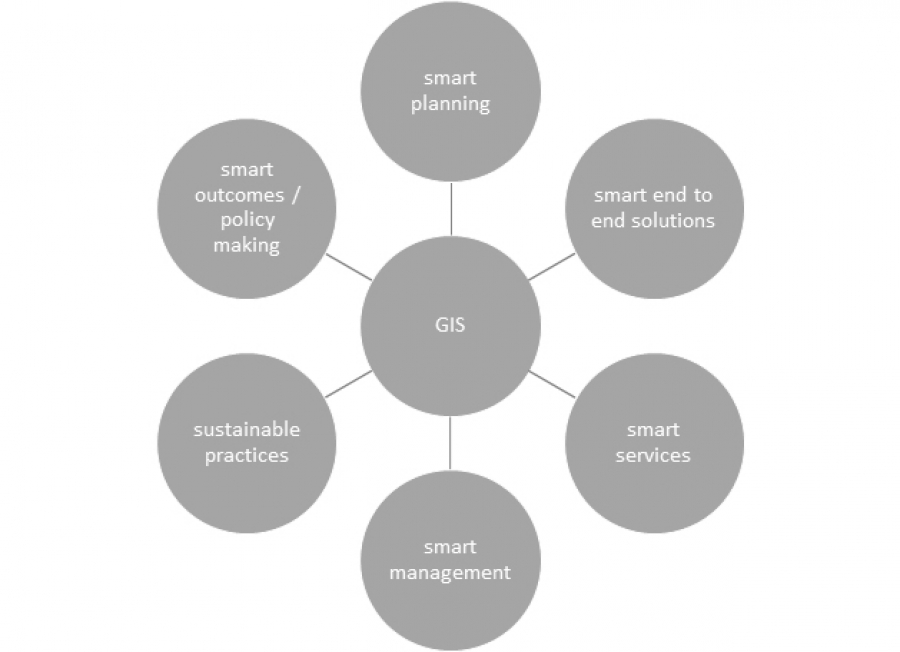News
Home | News | Developing Smart Cities Using GIS
Developing Smart Cities Using GIS
Smart Cities are commonly defined as “a data-driven urban environment aimed at sustainability, transparency and efficiency, driven by an ICT enabled model rendering a visual framework, and a seamless use of disruptive technologies in various application scenarios, served by an intelligent community framework”.
The sustainable development of urban areas is of key importance for local government. It requires policy makers to adopt new, efficient, and user-friendly technologies, in the areas of energy, transport and ICT. However, these solutions require an integrated approach, both in terms of research and development of advanced technological solutions.
A great example of an evolving Smart City is London. As the population, which is set to grow by 1 million over the next 10 years places excessive strain on healthcare, transport, energy, utilities, waste and pollution.
In order to address the identified strains and implement a 10-year plan, London must embrace new technologies and use its creative know-how so that it can adapt to meet the growing demands of its citizens. The city also needs to adopt a new form of collaboration between its citizens, government, businesses and academia so that these changes work for everyone.
To enable a strategic, collaborative approach, London needs to become a more transparent open city and invest in technology and data to ensure infrastructure improvements and developments in -
- enterprise: enabling businesses to respond to demands
- skills: improving access to knowledge and training
- energy and utilities: efficient management of resources to absorb new pressure while reducing carbon impact
- safety: such as, enabling cross-agency responses to emergency call-outs
- health: new ways to provide holistic patient care, including preventative medicine
- transport: planning and managing journeys to reduce congestion
The steering committee formed of representatives from key groups need to embrace smart technologies which not only integrates with existing processes and systems but promotes cross functional collaboration between the multiple teams.
How GIS is central to developing smart cities
A GIS provides decision makers with the tools to the visualise, analyse, plan, co-ordinate and make informed strategic based on their key project objectives. Furthermore a GIS provides policy makers with the opportunity fulfil all of the functions identified in the diagram below, which is critical when creating a smart city or when making decisions which is dependent on location data.

The concept of a smart city has continued to generate a lot of buzz during Q1 of 2016, which was stimulated when the Mayor of London, announced that they would be joining the Smart Cities and Communities Lighthouse Programme. The primary objective of this programme is to demonstrate how innovative uses of technology can improve the lives of its citizens.
The Smart Cities and Communities Lighthouse programme, part if the Horizon 2020 European Project, aims to develop solutions to challenges faced by all major cities as they continue to grow and develop.
The Smart Cities and Communities Lighthouse programme announcement comes after the major of London, published the Infrastructure Plan for 2050 – the first attempt to set out a full range of infrastructure requirements for the capital. The plan which considered how data and smart technology could be embraced to influence the future of the city. This was followed by the announcement of the London Data Store, which was seen as the first step towards freeing up London’s data.
This is evidence that developing a smarter city, for its citizens is essential in order to accommodate the growing population and the identified strains.
However, joining these projects and the freeing up of data is pointless if the steering committee can’t visualise, analyse and plan strategic change. This is where a GIS become a valuable tool.
Using a web GIS in the planning and development of smart city
To create a smart city a GIS should be deployed and referred to at every stage of the planning and strategic development of a smart city. The GIS should operate throughout all stages of the project life cycle from modelling, planning, analysing, building and managing.

- Spatial planning – with one or more thrust areas of deployment.
- GIS-ICT – underlying scalable framework, with seamless flow of data / information; connecting departments and stakeholders
- Collecting – digitization of geodata, spatial databases, sourcing data critical to ‘smart’ city management
- Processing – data management in real time, maintenance of open data protocols, integrating service oriented architecture (SOA) with a data service architecture that leaves no place for data silos
- Communicating – a two-way flow of information between participants, stakeholders and citizens; real time alerts and action in a distributed computing environment
- Analysis – crunching of structured (digitized) and unstructured (social, surveys) big data for analysis in real time
- Data-driven decision making – the ‘always connected’ ecosystem, makes possible real time managements and decision making
This highlights that GIS technology performs functions that cannot be carried out by any other technology, especially when relevant to location based data.
Using a GIS provides government officials, data analysts and administrators with the opportunity to consolidate processes by moving data onto a single GIS platform which supports third party integration with WMS or Api calls. Adopting an effective GIS will provide essential administrative support, which if a web GIS is adopted can be administered internally or remotely.
Prior to selecting a GIS it is important to understand the technological capabilities, feature components, initial and ongoing costs associated with the implementation. This will ensure that the GIS selected will support both the immediate and long term objectives of the steering groups requirements.
Get in touch to discover how Azimap can be used to fulfil the requirements of your urban regeneration or development plans.



